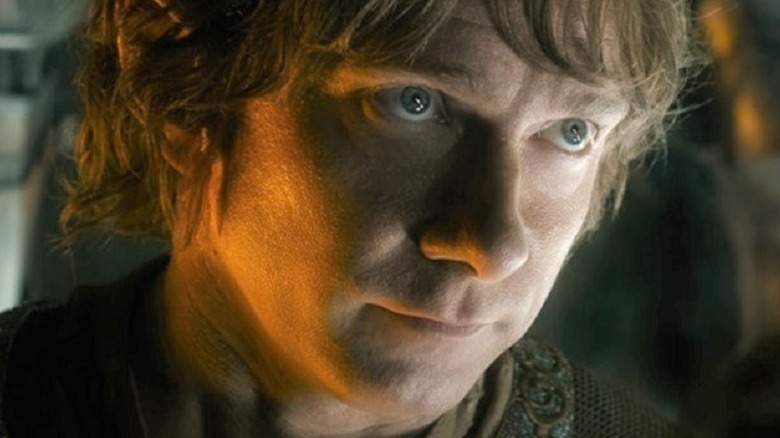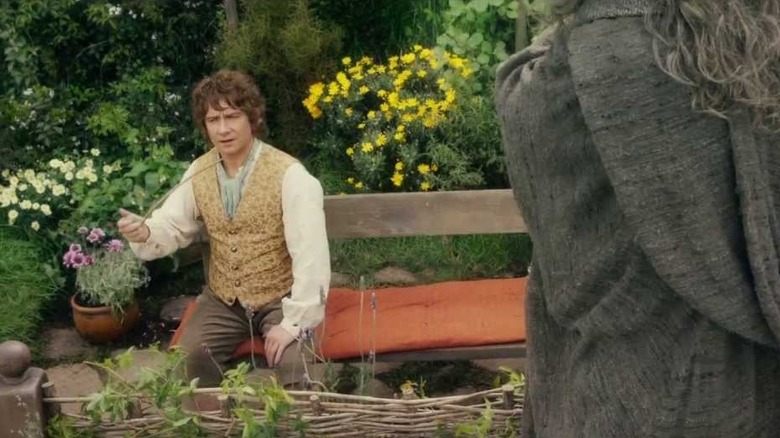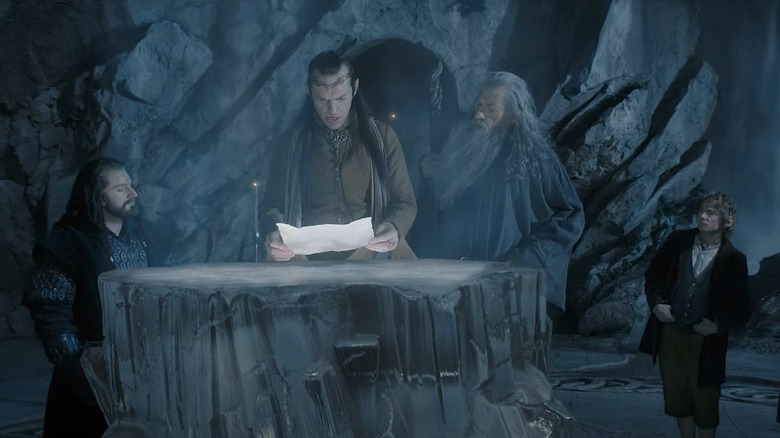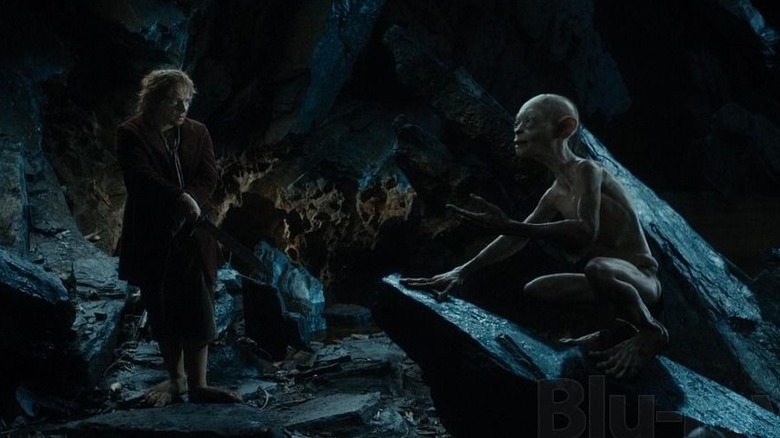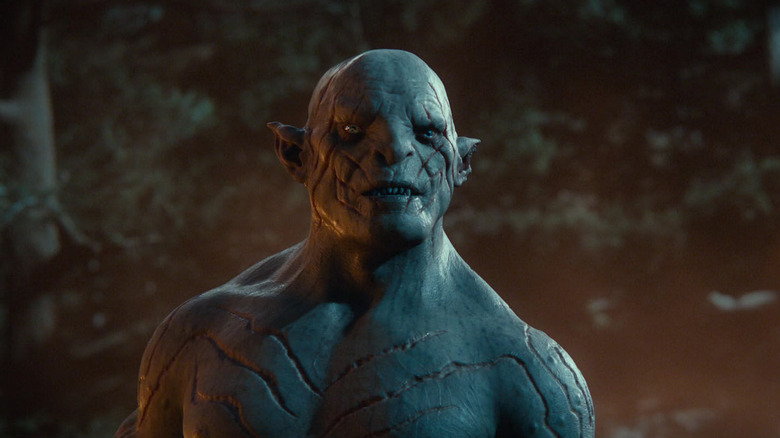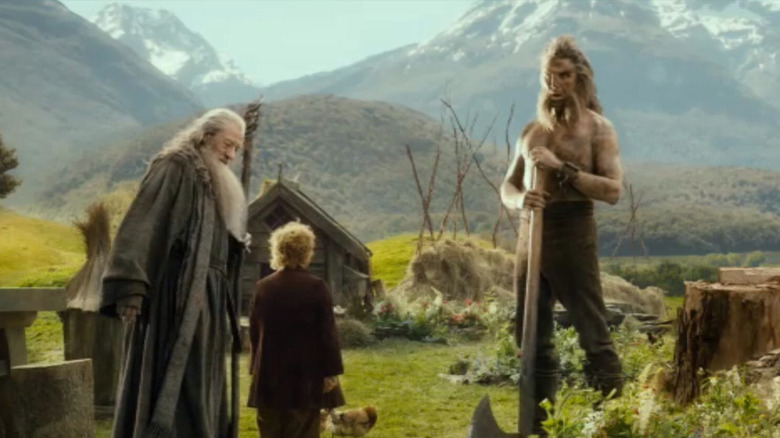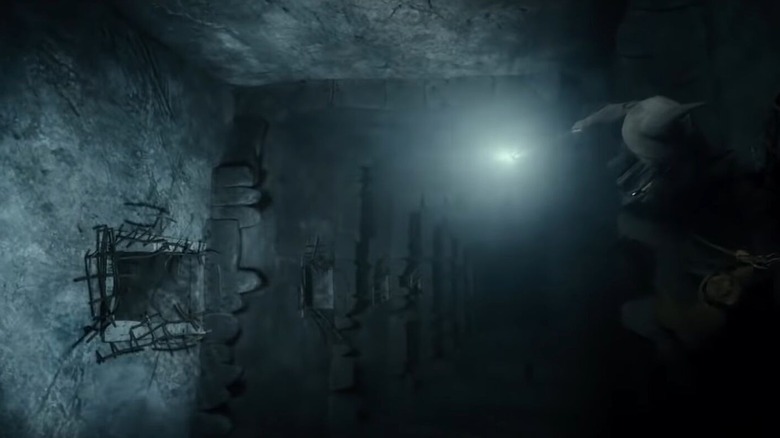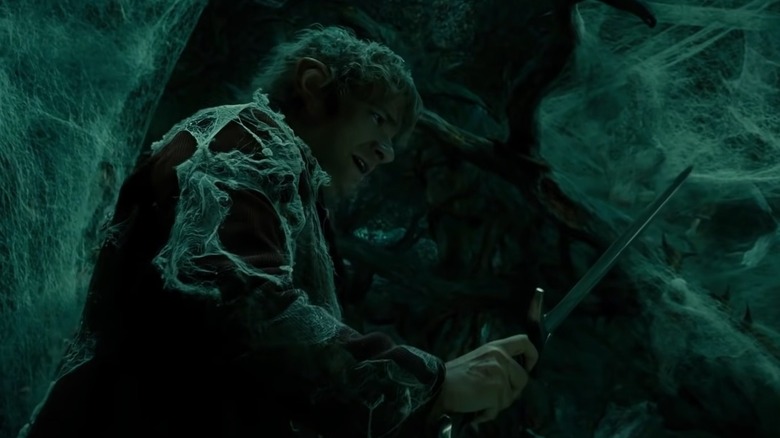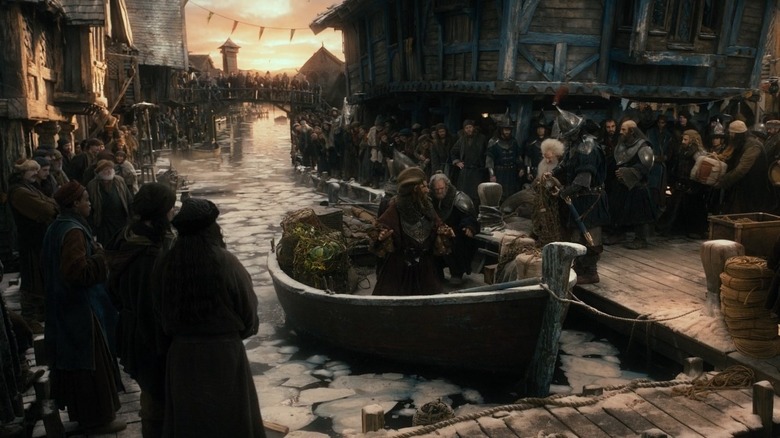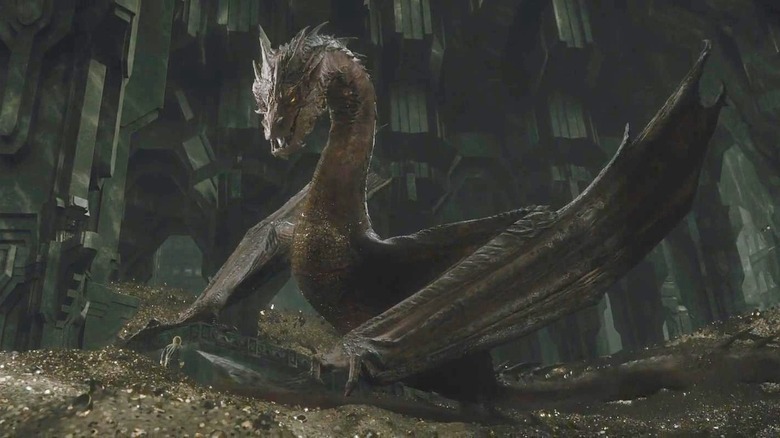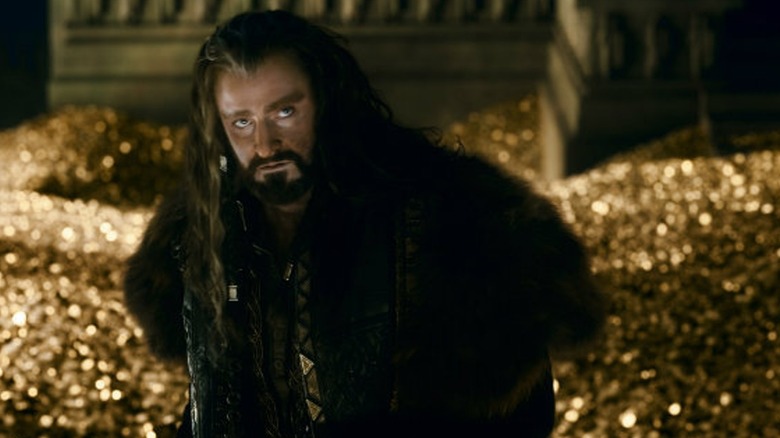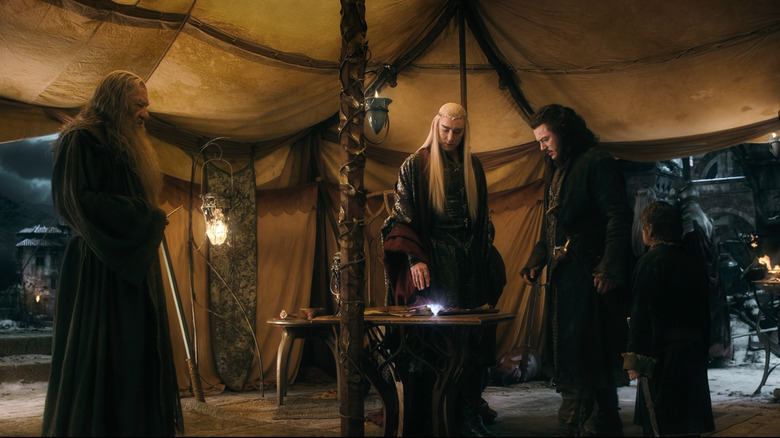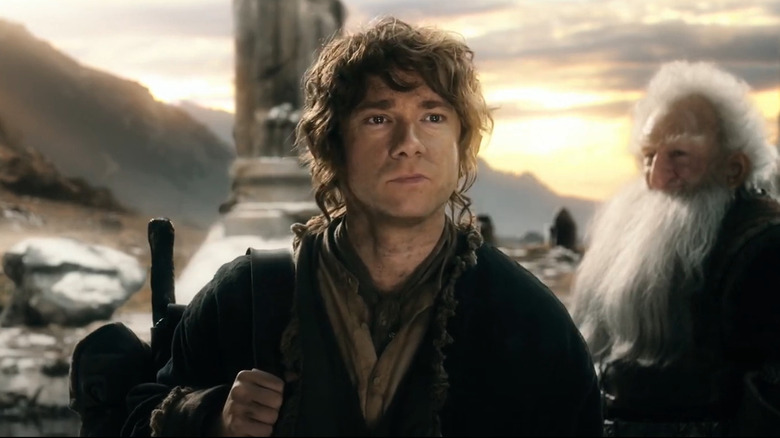The Hobbit Timeline Explained
J.R.R. Tolkien's "The Hobbit" is a timeless fantasy classic. The book follows a simple adventure story, is only a few hundred pages long, and can be read in a handful of hours by parents and children alike. So, when it was announced way back when that New Line Cinema and Warner Brothers had a "Hobbit" adaptation in the works — and that it would be three movies long — it started to turn some heads.
After all, with an extended run time that goes over the eight-hour mark, one can make the case that you can read the entire book and still have time for a nice nap before the films have ended. Not surprisingly, the extraordinary length of the films comes from a massive amount of extra material. Some of this is pulled from other parts of Tolkien's legendarium while others (read: random elf/dwarf romances and the like) are tossed in just to keep everyone nice and confused.
The truth is, the "Hobbit" trilogy takes a fairly linear story and turns into a convoluted, CGI-filled hot mess. So, we've decided to wade into the madness and try to make some rhyme and reason out of it all. Here's a comprehensive timeline of Peter Jackson's "The Hobbit" trilogy (complete with some desperately needed additional notes from the original book to help make head or tail out of it all).
An unexpected ... trip forward in time?
The first film in the trilogy is "The Hobbit: An Unexpected Journey." The movie starts out with a nice blast from the future as we see Bilbo Baggins (played by the late Ian Holm) penning an account of the past. We get a rapid exposition of the history of the Lonely Mountain and the destruction created by Smaug.
After this quick connection to "The Lord of the Rings" movies, the story jumps 60 years into the past, where we see the iconic meet-up between Gandalf and Bilbo (now Martin Freeman) that takes place in the first pages of "The Hobbit." In the aftermath of the meeting, Bilbo's peaceful life is turned on its head as he finds himself hosting an unexpected party of dwarves who are setting out on a quest to reclaim their homeland from a fiery dragon. Gandalf orchestrates everything, and before long — and in spite of doubts harbored by the chief dwarf, Thorin — Bilbo finds himself stepping into the role of "burglar" for the group.
From there, the halfling is uncomfortably swept off on the adventure. Before they get too far along their journey, the group runs into their first major roadblock — a pack of three slapstick trolls. These bumbling brutes catch the party and argue over how to eat them, that is until they're turned to stone by the early morning sunshine. After this harrowing episode, the group plunders the trolls' lair, and Bilbo officially receives the short elven dagger that will eventually be known as Sting.
A short, information-filled rest
After their escape from the trolls, the dwarves, Gandalf, and Bilbo attempt to reach the hidden fortress of Rivendell. And it's here that the story really starts to deviate from the book. On their way, they run into Radagast the Brown, one of the Five Wizards, who informs them that a dark presence has appeared over the Misty Mountains in the fortress of Dol Guldur in the forest of Mirkwood. From there, the group is attacked by goblins, which are destroyed by a group of elvish warriors from nearby Rivendell.
Once in Rivendell, the facts just keep on piling up. The elvish leader Elrond finds moon-letters on the group's magical map — runes that informs them of a secret way into the mountain. Gandalf and Elrond also attend a meeting of the White Council where the evil in Mirkwood is discussed, and we start to get a glimpse into the fact that it's Sauron retaking shape as the Necromancer. Finally, we see the ambushing goblin captain report back to his leader, Azog, a huge, white orc who has a long-standing beef with Thorin.
As a quick aside, this is where the story starts to go in a bunch of different directions. However, in the original book, both the Necromancer and Azog are only peripheral characters. In fact, Tolkien kills Azog more than a century before "The Hobbit," and his son, Bolg, takes his place for the later events. While Bolg is in the movies, Jackson and company apparently opted to keep his fearsome orc father/general alive to beef up the drama.
'Far over the Misty Mountains cold'
After their stay in Rivendell, the dwarven party heads over the Misty Mountains. Along the way, they dodge some giants in a thunder battle, and then the group shelters in a cave. Here, Bilbo decides to abandon his friends (definitely something that didn't happen in the book), but the whole group is ambushed by goblins before he can leave. They're brought to the Great Goblin in Goblin-town, a subterranean dwelling hidden deep under the mountains.
Here, Gandalf comes to the rescue, killing the Great Goblin and helping his friends escape in a truly ridiculous manner. In the chaos, Bilbo is separated from his companions. It's at this point that he finds the One Ring and encounters the infamous Gollum. The two halflings engage in the famed riddle-game, which ends with Bilbo stumping Gollum with a not-quite-riddle and then running for his life when the wretched creature realizes that Bilbo has his precious.
During the ruckus, Bilbo realizes that the ring that he found makes him invisible — although he still has no idea how terrifyingly powerful it is beyond mere wraith-like imperceptibility. The merry chase leads Bilbo back out of the Misty Mountains, where he links back up with the dwarves. Everything seems to be okay. But Gandalf, the dwarves, and Bilbo are safely out on the other side of the mountains for a matter of seconds before the trouble kicks up again.
Azog comes a-knockin'
After escaping the Misty Mountains, Bilbo and company are attacked by a talking race of wolves called wargs and are forced to scramble up a tree for safety. Then the situation goes from bad to worse when Azog and his goblins also arrive on the scene. Things take a turn for the extra-dramatic once again when the tree holding our heroes is partially uprooted and left hanging off a cliff. We then get multiple rounds of halfway-heroics as Thorin charges Azog and is hurt, Bilbo gets between the villain and his prey, and then some of the other dwarves rush in to help.
The entire situation is completely hopeless ... until Tolkien's favorite eucatastrophe tool, the eagles, swoop down and save the day. They nab the dwarves, Gandalf, and Bilbo, snatching victory from the jaws of defeat and flying them to safety — and also taking them a good step closer to the distant Lonely Mountain. It's at this point that Thorin finally accepts Bilbo as part of their party, acknowledging his bravery and welcoming him as their expert burglar.
This is where the first movie ends. Already bloated and overly complicated, it speaks volumes that "The Hobbit: An Unexpected Journey" is arguably the easiest part of the trilogy to follow. Even though it introduces non-book storylines, such as the White Council and Azog's shenanigans, it primarily fills in the back story, launches Bilbo's adventure, gets him to Rivendell, and then over the Misty Mountains. Oh, yeah, and he finds the One Ring as well.
Seeking shelter from a skin-changer
The second film, "The Hobbit: The Desolation of Smaug," once again starts with a brief bit of exposition. It shows Gandalf and Thorin linking up for the first time at the Prancing Pony in Bree. This is another bit that's pulled in from Tolkien's extra material, specifically his posthumously published book "Unfinished Tales."
After we see how the Quest of Erebor begins, the primary timeline picks up again, and we find Azog and his soldiery chasing our short-statured heroes. They take shelter in the home of Beorn the skin-changer — that is, after he nearly catches them in his bear shape. Once back in human form, their odd host gives shelter to his guests and then sends them on their way with provisions to help them get through the long journey through Mirkwood.
It's at this point that the movie gets really weird (and upsetting) for many diehard Tolkien fans. In the book, Gandalf leaves the party on the edge of Mirkwood so that he can attend to some unspoken business. However, in the films, things get much more detailed — and not in a good way. The wizard communicates, apparently telepathically, with the Lady Galadriel and then splits off from the group to investigate ...the tombs of the Nazgûl?
Gandalf goes way off script
Alright, since the goal here is to make sense of the larger "Hobbit" trilogy timeline, we're going to stick with Gandalf's sideshow for a minute. When the wizard reaches the tombs of the Nazgûl (which are made-up for the film), the wizard discovers that their ghostly inhabitants have been revived, which, wait, what?
This is a complete retconning of the actual origins of the Ringwraiths from Tolkien's books. But the event does quickly establish that the Necromancer is, indeed, Sauron — the only person who can command the Black Riders. The decision to make up a new origin story for the Nazgûl may have been fueled by little more than making things easily digestible for the audience. Which, hey, if it helps the narrative flow, who cares if it's canon, right? Cough. All right. Moving on.
After the random discovery of the Ringwraiths' awakening, Gandalf keeps doing very un-Tolkienian things by sending Radagast to warn Galadriel of the danger while he pays a visit to Dol Guldur in secret. Here, he's attacked and made captive after witnessing the growing power of the stronghold.
In "The Hobbit: The Battle of the Five Armies," Gandalf's Dol Guldur adventures wrap up when Elrond, Saruman, Galadriel, and Radagast arrive. They're confronted by Sauron and the nine Nazgûl, but the good guys, led by Galadriel, manage to get Sauron to retreat. After that, the whole Necromancer subplot mercifully wraps up.
Back in Mirkwood
The entire side adventure with Gandalf and the Necromancer is only referenced in the original book, and the truth is, it tends to add to the confusion of the movies. However, now that we've gotten it out of the way, we can focus back on the main story.
Last we left him, Bilbo was about to join the dwarves on a trip through Mirkwood. This deadly jaunt through the dark, arboreal menace ends up going very, very poorly. Before long, the group begins to run out of food. They also have a tough time crossing a magical river. Finally, they're captured by the giant spiders — who are likely descendants of Shelob — that dwell in Mirkwood. It's only thanks to Bilbo's heroics that the group survives their brush with the oversized arachnids.
Going from one danger to the next, the companions are quickly captured by a group of Wood-elves led by the one and only Legolas. At this point, we also meet Tauriel, a captain of the guard and a character invented for the film adaptations.
The dwarves are brought back to the Wood-elves' underground realm, where they're imprisoned. During this time, a random B-plot romance springs up between the dwarf Kíli and Tauriel. Thorin also makes it clear that he won't play ball with Legolas' dad, the elven king Thranduil. Eventually, Bilbo uses his magic ring to bust his friends from prison and they escape down a nearby river in empty barrels.
Lake-town and the Lonely Mountain
Once they escape from the perils of Mirkwood, Bilbo and the dwarves reach Lake-town with the help of Bard. Bard is a man and the heir to the throne of nearby Dale, a Smaug-stomped city of men located next to the Lonely Mountain. After a brief stop in Lake-town and a dubious blessing from its corrupt Master, the intrepid crew heads for the Lonely Mountain where Bilbo spearheads the discovery of the secret door.
It should be mentioned that, during this time, yet another B-plot gets going. In the escape from the elven palace, Kíli is shot and poisoned. He and a few others end up staying behind in Lake-town. There, they're ambushed by a hunting party sent by Bolg, but Legolas and Tauriel arrive in the nick of time and save the day. Then Tauriel heals Kíli, and their mutual interest is more openly expressed. Eventually, after events with Smaug are wrapped up, these dwarves follow their kin to the nearby mountain. Throughout this time, Bard is also captured and put in prison for resisting the Master of Lake-town.
All of this is confusing, hard to follow, and once again doesn't take place in the book. In the original manuscript, the dwarves remain together. All of the drama that takes place with Bard is also completely made up for the movie. If it added genuine value, it might be excused. But the truth is, it makes the story much harder to follow.
Dealing with Smaug
Bunny trails aside, after the hobbit and the dwarves find the secret door on the side of the Lonely Mountain, Bilbo pops on his ring and pays Smaug a visit. This is followed by a heart-in-your-throat kind of encounter with the Golden Dragon himself. Eventually, Thorin and his companions muster the courage to join their friend. Quickly taking in the situation, the group hatches a plot on the fly to kill Smaug.
They trick the dragon into rekindling the old forges of the mountain. They then literally melt a lake of gold, pour it into a statue, and then try to drown Smaug in it (a convoluted concept that's not in the books). When the gold dust settles, Smaug flies off to get his revenge on the men of Lake-town who clearly enabled his attackers. As he watches the beast fly off, Bilbo exclaims, "What have we done?"
At this point, we've officially entered "The Hobbit: The Battle of The Five Armies" territory. When Smaug reaches Lake-town, he meets his match in the form of Bard. The hero breaks out of prison, gets his famed Black Arrow, and uses it to kill the dragon.
The clouds gather
After Smaug's death, the story takes a bit of a breather. Lake-town is destroyed, and its people head for the nearby ruins of Dale looking for new — or technically old — shelter. In the Lonely Mountain, Thorin falls victim to the Dragon Sickness and orders his tiny group of companions to prepare to defend his reclaimed realm from what he perceives as the greedy men of the Lake and an approaching army of Wood-elves.
Legolas and Tauriel also travel all the way to Gundabad (a trip that is, once again, not in the book) and discover that Bolg is leading an army and hoping to link up with his dad's forces, which are already near the Lonely Mountain. On top of all this, an army of dwarves commanded by Thorin's distant cousin, Dáin Ironfoot, comes speeding to the help of their trapped relatives.
It's a bit confusing, but suffice it to say that, once the dragon is killed, a lot of different armies, groups, and individuals begin to gather at the mountain — most of whom are naturally attracted by the luxurious, virtually unguarded treasure horde.
A thief in the night
The gathering of so many enemies clearly spells trouble in the future. But before any fighting breaks out, Bilbo exercises his burglarious muscles one more time. When he first found the Lonely Mountain treasure, the hobbit discovered and hid the Arkenstone, the greatest prize of the entire horde and a jewel that Thorin desired above everything else. Now, with the dwarves' enemies gathering outside, Bilbo sneaks out of the mountain and offers the jewel to the men and elves to use as a bargaining chip. The hope is that they'll be able to get some of the treasure without any fighting taking place.
Bilbo's heroics are admirable, but they fail. Thorin's Dragon Sickness is too strong. Also, Dáin and his tough-as-nails soldiers arrive just in time to help him defend his treasure. Everything looks like it's about to go seriously south, but before the groups can come to blows, Azog's and Bolg's united armies attack, forcing elves, men, and dwarves to turn and face their common enemy.
A battle and an ending ... and a beginning
At this point, the Battle of the Five Armies is in full swing. The official "five armies" being referenced here include the Wood-elves, dwarves, men, goblins, and wolves. However, a horde of bats — as well as Gandalf, Beorn, Bilbo, and the eagles — are also involved.
Thorin also overcomes his Dragon Sickness and joins in the fray. It's a gutsy move that leads to the death of Thorin, Fíli, and Kíli. Legolas also kills Bolg, and Thorin kills Azog. So, yeah, after a long stretch of survival, we lose a lot of characters as the story wraps up. Before the dwarven king dies, Thorin also bids a fond farewell to Bilbo.
Disenchanted by the whole affair, Legolas decides to leave the Woodland realm, and his father encourages him to seek out a young man named Strider. (Except, yeah, Aragorn's like 10 years old at the time — plot hole, anyone?)
Finally, as the story winds down, Bilbo bids a fond farewell to his surviving dwarven companions. He then heads home, accompanied by Gandalf until he reaches the borders of his homeland. When he arrives back at Bag End, he finds that he's been presumed dead, and his possessions are being auctioned off.
As Bilbo begins to pick up the pieces of his old life, the story shifts back to the older Bilbo just before his 111th birthday party. The scene shows Bilbo's perspective in the opening moments of "The Fellowship of the Ring" just as Gandalf first arrives at his house. This allows the story to feed right into the beginning moments of "The Lord of the Rings" trilogy that follows.
